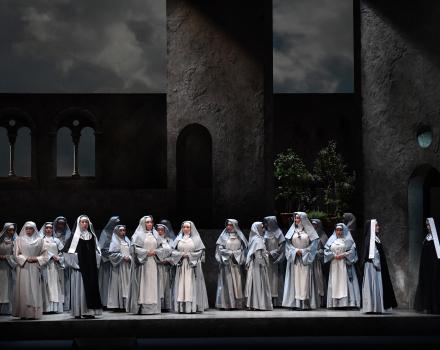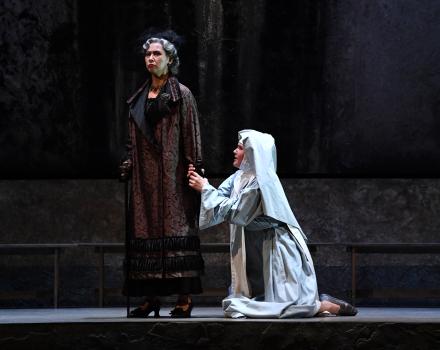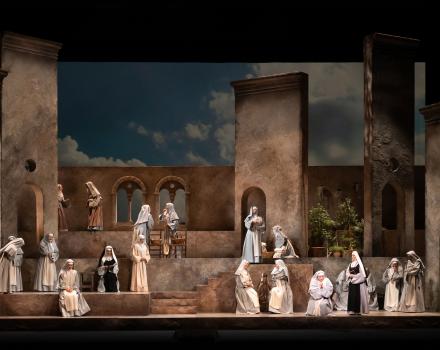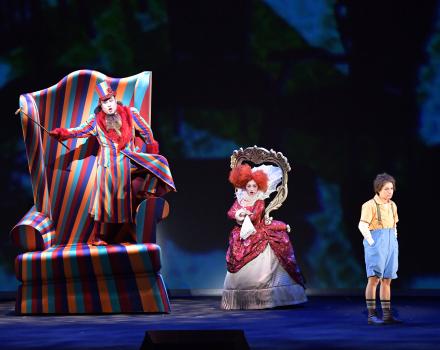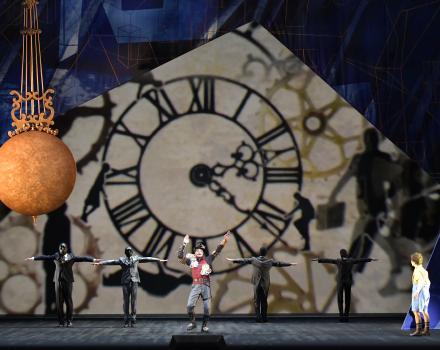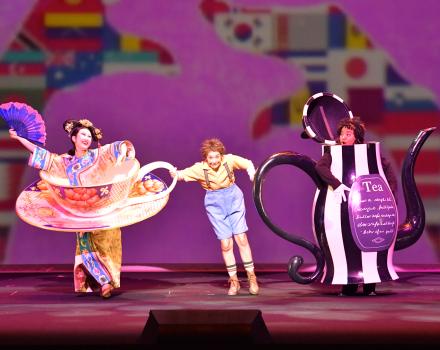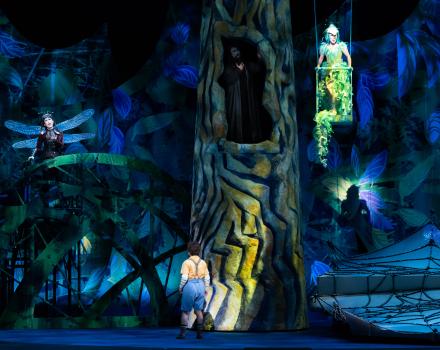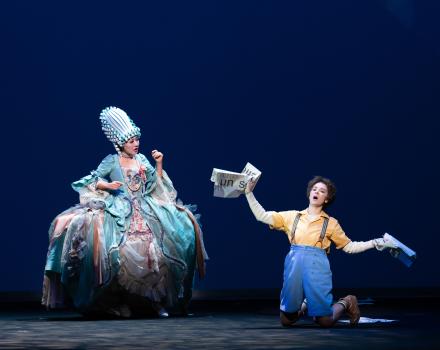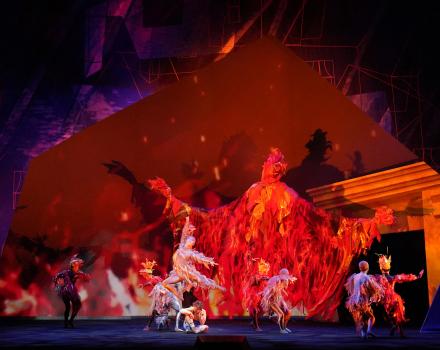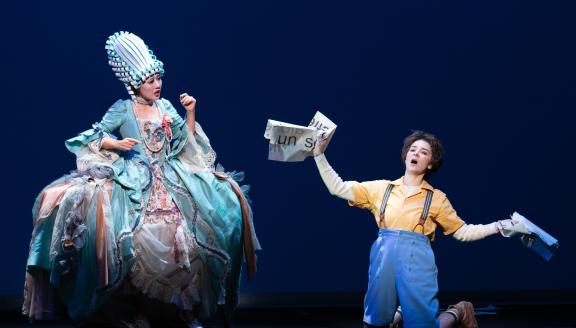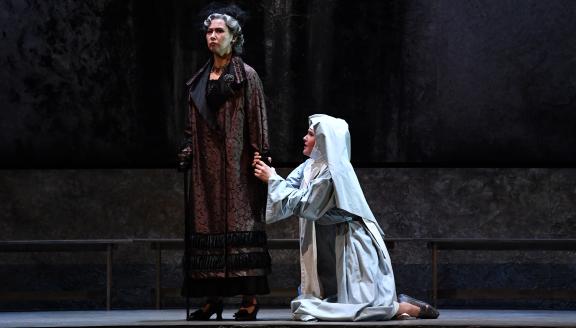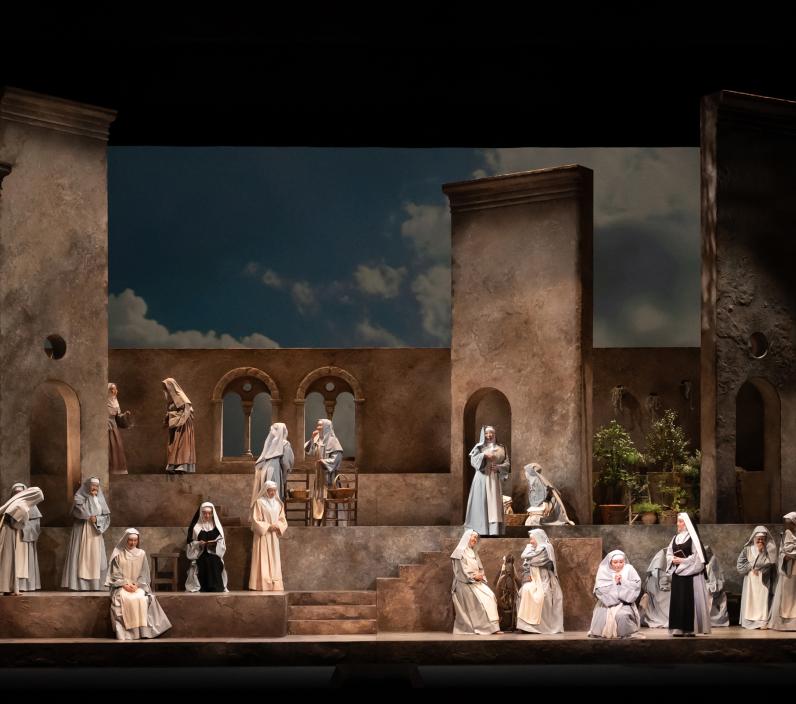
A double bill from OperaVision’s most easterly partner, New National Theatre Tokyo. Puccini’s Suor Angelica concerns the power of a mother’s love and the devastation of losing a child. The second half of our evening sweeps away all sentimental drama, and there opens the world of a teapot dancing the foxtrot with a Chinese cup, an armchair courting a Louis XV chair, objects and animals joining forces against a naughty child. This is the world of L'Enfant et les sortilèges, the ‘fantaisie lyrique’ by Ravel.
In little under an hour, Puccini’s Suor Angelica demonstrates how music can stir our most profound emotions. A group of nuns discuss their desires, but Sister Angelica claims that she has never truly desired anything. This is a lie, because every single day since arriving at the convent, she has longed for her son, who was taken from her. When her aunt informs her that the little boy died several years ago, Angelica’s world collapses. First performed in New York in 1918, Suor Angelica shows Puccini at ease with the religious music of his ancestors but also in writing music with an electric dramatic charge - such as that of the meeting between Sister Angelica and her glacial aunt.
In 1914, the director of the Paris Opera, Jacques Rouché, commissioned a libretto of L'Enfant et les Sortilèges from the writer Colette, who wrote it in 1916. After numerous exchanges between Colette and Ravel, the project gradually took shape, albeit very slowly. It was not until 1924 that Ravel really began composing the work, completing it only five days before the premiere. This finely orchestrated musical gem shows the composer’s taste for humour, childhood poetry and animals - an affection he shared with Colette, particularly for cats!
Two operas seem to be from two completely different worlds. As director Jun Aguni describes below ‘they however have common factors, such as insight into human nature and the fact that they make us reflect about our world today. Feel free to interpret them as you wish and enjoy.’
Cast
Orchestra | Tokyo Philharmonic Orchestra |
|---|---|
Chorus | New National Theatre Chorus |
Children Chorus | Setagaya Junior Chorus |
| ... | |
Conductor | Ryusuke Numajiri |
|---|---|
Director | Jun Aguni |
Sets | Atsumi Yokota |
Costume | Emi Masuda |
Lighting | Masao Oshima |
Choreography | Noriko Ito |
Chorus Master | Hirofumi Misawa |
Children Chorus Master | Midori Kakee |
| ... | |
Suor Angelica
Suor Angelica | Chiara Isotton |
|---|---|
La zia principessa | Junko Saito |
La badessa | Megumi Shiozaki |
La suora zelatrice | Akiko Goke |
La maestra delle novizie | Yuka Kobayashi |
Suor Genovieffa | Maki Nakamura |
Suor Osmina | Hare Ito |
Suor Dolcina | Sachie Konno |
La suora infermiera | Ryoko Suzuki |
Prima cercatrice | Yoriko Maekawa |
Seconda cercatrice | Mari Iwamoto |
La novizia | Shihori Wada |
Prima conversa | Nagisa Fukudome |
Seconda conversa | Akiko Osakabe |
| ... | |
Music | Giacomo Puccini |
|---|---|
Text | Giovacchino Forzano |
| ... | |
L’Enfant et les Sortilèges
The Child | Chloé Briot |
|---|---|
Mother | Junko Saito |
The Armchair / A Tree | Taiki Tanaka |
The Shepherdess / A Pastourelle / The Owl /The Bat | Mao Morita |
The Comtoise Clock / The Cat | Teppei Kono |
The Chinese Cup / The Dragonfly | Shoko Sogo |
The Fire / The Princess / The Nightingale | Rie Miyake |
A Shepherd / The cat / The Squirrel | Yuki Sugiyama |
The Teapot 'Wedgwood black' | Takayuki Hamamatsu |
The Little Old Man / The Tree Frog | Hideyuki Aochi |
| ... | |
Music | Maurice Ravel |
|---|---|
Text | Colette |
| ... | |
Videos
Story
Suor Angelica
The action takes place in a convent near Siena. Suor Angelica was banished to a convent after bearing an illegitimate child. She has not seen her family for seven years.
The sisters emerge from the chapel, going about their daily routine. Sister Genovieffa rejoices in it being the first of three evenings in the year when the sunset light strikes the fountain, turning its water golden.
The nuns begin to discuss their own desires, but Suor Angelica claims to have none. However, the sisters gossip, knowing that Angelica’s greatest wish is to hear from her family, but are interrupted when the Infirmary Sister enters, asking Angelica to help with a herbal remedy for wasp stings. A grand coach is sighted outside and the Abbess announces the visitor, Angelica’s aunt, the princess.
Alone, the Princess explains that Angelica’s sister is to be married and that Angelica needs to sign a document renouncing her inheritance. Angelica asks after her child, but is coldly told that the boy died of a fever two years earlier. Devastated, Angelica signs the document. Her aunt leaves.
Angelica grieves that her child died without his mother by his side (‘Senza mamma’) and decides to take her own life by drinking a poison she has concocted from flowers from the convent garden. After drinking it, she realises she has committed a mortal sin, damned from being reunited with her son. She begs the Virgin Mary for forgiveness and, as she dies, a miracle produces a vision of her child, greeting her from heaven.
L’Enfant et les Sortilèges
A Child grumbles over his homework and is punished by his Mother, fed dry bread and tea without sugar. He angrily takes it out on the animals and objects around him in a temper tantrum, knocking the teapot and china cup off the table and pricking the caged squirrel with his pen nib, poking the fire, tearing up his books and vandalising the wallpaper. To his shock, his room comes alive and the objects revolt against him: the armchair and bergère celebrate being rid of him; the Grandfather Clock mourns its broken pendulum; teapot and china cup dance a foxtrot; Fire licks and darts towards him. Shepherds on the wallpaper lament their torn pastoral scene, a Princess rises from the pages of the mutilated storybook, and a little old man – Arithmetic – terrorises him. Two cats appear and the Child follows them into the garden. It is night.
The Child is happy to hear insects and frogs and the hoot of an owl, but a Tree groans, bleeding sap from the knife wound the Child inflicted earlier that day. The animals shun him and, in his despair, he calls for his Mother (‘Maman!’). In a desire for revenge, they throw themselves on the Child. During the tussle, a squirrel is injured. The Child bandages its paw and collapses. Witnessing this act of kindness, the animals are moved and carry him back to the house. A light goes on and the animals withdraw as the Child, holding out his arms, calls ‘Maman!’
Insights
Director’s Note
by Jun Aguni
My intention is to present Puccini’s Suor Angelica and Ravel’s L’Enfant et les Sortilèges as two independent pieces, each with its own scenery. As a director, I will portray two stories in two different worlds, each with its own ending.
At first glance, the world of Suor Angelica is a peculiar one. Seen from outside, the nuns are a faceless group, who dress the same and live in the enclosed space of a convent. As servants of God, the nuns are not allowed to harbour any desires. In fact, the rule-bound lifestyle and unique flow of time within the closed space is depicted in the first half of the opera. Like ruffling through petals, Puccini and librettist Forzano illustrate the past of each one of the nuns. Each nun has emotions as well as small hopes. They are, by no means, a faceless group. Through the humble hopes that the nuns confide, the individuality of each one of them emerges. It comes to light that Angelica, who seemed the most faultless of all, harbours the most ‘sinful’ hope. She has been living 7 years in the convent, clutching onto the hope of seeing her son, who was taken away from her at birth.
There are no male characters in this opera. The person who visits Angelica to inform her that her son has died is a woman, a Princess. This character could have been a man, but it might have been made a woman intentionally. The Princess’ attitude towards her niece Angelica is cold on the surface. But, is she just a hard-hearted person? In the visitation room scene, we are able to get a glimpse of what her life has been like. Angelica is trapped in the space of the convent. After the death of Angelica’s parents, the Princess is entrusted with the care of her two nieces. Within the patriarchal society at the time, it was like being trapped within a society that coerced the Princess to bottle up her emotions in order to shoulder the responsibility of being an aristocrat.
What happened the moment Angelica died, could have been a miracle the audience can share? Was it something only she could see? If at least Angelica was able to feel salvation at the moment of death, that in itself can be called a miracle. Hopefully she was smiling at the time of her death. That is the ending that I want to present.
On the other hand, the main character of L’Enfant et les Sortilèges is a 6 or 7 year old child. It brings to mind the Italian tale Pinocchio. A child cannot live by his/her own wishes for the exact reason that he/she is a child. The child’s angry plea for freedom is linked with his violent behaviour. What is freedom and to what extent is it permissible? Through his experience in the world of spells, the child is at times hurt, he learns that actions bring about results and that his actions cause tragedies in dimensions beyond his imagination.
If a child makes a mistake he/she can start over again. What about an adult? What about us? What if one grows up with a narrow outlook on things and hurts someone unconsciously? What would we be able to do once we realise we have hurt something? Humans inevitably live in connection with others. We will not be able to survive if we continue to hurt nature.
The peculiar world that materialises in front of the child makes us think. For example, the cup talks in a language that sounds like Chinese or Japanese, as if expressing cultural and value differences. The shepherds that are torn seem like refugees who have been robbed of their homes. The child being chased by time and numbers resemble modern man. Those who have been murdered have loved ones who cry over their loss. Those who have been incarcerated and deprived of their freedom for irrational reasons, expose their grief and anger. Nature that has been destroyed. These things condemn and attack the child. Excited crowds attack someone in the name of justice and gradually forget their cause and they hurt each other. If we are hurt and we see someone who is more vulnerable than us hurt in front of our eyes, would we extend a helping hand like the ‘child’ did?
I believe that humans are equipped with good will and conscience. When the child tried to help the small squirrel and realised how helpless he was, the first thing he uttered was ‘mother’. A mother is the Source of life. She represents the beginning of life. In this opera by Ravel, the mother does not appear neither at the beginning, nor at the end.
The ‘child’ probably grows up making mistake after mistake over and over again. The opera does not relate what happened to the ‘child’, what kind of a life he led, but he probably grew up and became an adult and went to his mother, the Source of his own life.
At first glance, these two operas seem to be from two completely different worlds. However, they have common factors, such as insight into human nature and the fact that they make us reflect about our world today. Feel free to interpret them as you wish and enjoy.
Gallery
